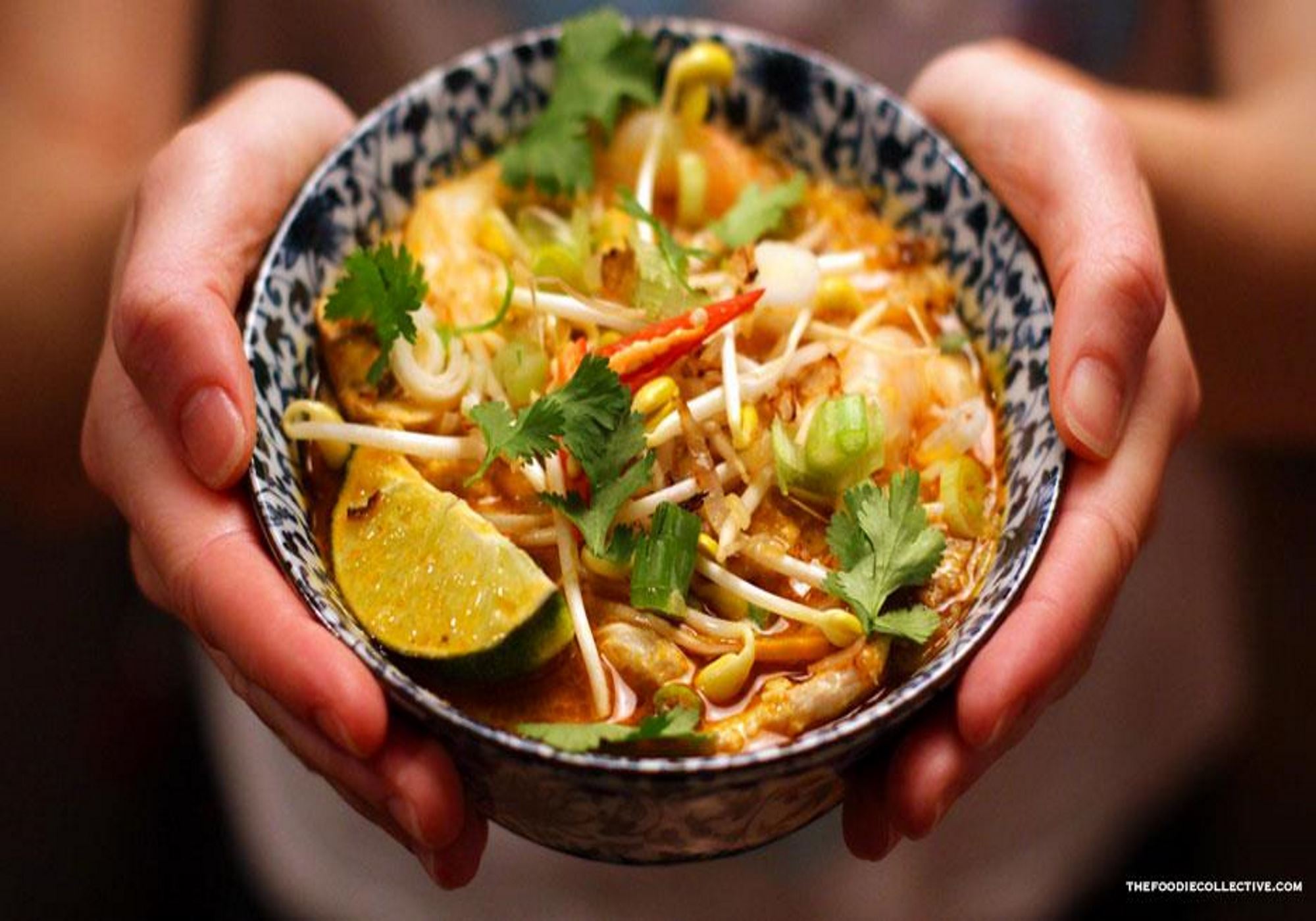

If it’s too sour, add a bit more sugar if it’s not sour enough, squeeze in a lemon.ĥ eggs (half egg per person, adjust accordingly)īean sprouts, lightly blanched in the soup Go heavy on the salt as you will need the extra hit once all the noodles and toppings are in. Strain the stock again, return to the heat and add in the coconut cream. Return the stock to the heat and add in the paste. Strain the stock, discard the bones and shells. The longer they infuse, the better the flavour. Add these roasted bones and shells back into the reserved poaching liquid and continue to cook for another 45 minutes.

Once you’ve separated the meat from the chicken bones, roast the bones and the prawn shells/heads in the oven until starting to brown up – about 45 minutes. Discard the poo shoots, hold on to the heads and shells. Remove the prawn shells and heads and devein the bodies. While the chicken is poaching, preheat the oven to 180C. Remove all the meat from the chicken, shredding it up as you go, and set to one side. Poach the chicken in 2 litres water for about an hour, until fully cooked. You can use coconut milk but the cream gives a fuller body and smooth mouthfeel) Heat 150ml of oil in a wok and fry the paste over a low heat for about 20 minutes, making sure it doesn’t burn.ĥ0g tamarind, soaked in a small bowl of boiling water (just enough to cover)Ĭontinue cooking over a low heat for about another 30 minutes until the paste is starting to really brown up.ġkg of prawns (shells and heads intact) – 3-4 prawns per person type thingĥ00ml coconut cream (an extra can spare won’t hurt, just in case you want to adjust the flavour and or spiciness. Probably the most important ingredient of the paste – it will change the flavour profile dramatically. Glad-wrap, triple zip-lock bag, box up, refrigerate once opened. Small handful (5g) dried whole chilli, soaked in a splash of boiling waterġ00g onion, roughly chopped (about 1 large onion or 5 shallots)ġ5g ginger, sliced (about half a lady’s thumb)ģ0g galangal, sliced (double the size of the ginger)ĥg belacan (THE FUNK. Toast all of the above in a dry pan until fragrant. But I wouldn’t put it past any business-savvy person to lie about a key ingredient. I have used curry powder in the paste… a lot of people are quick to say that what differentiates Sarawak laksa from other laksas is that it doesn’t use curry powder. My go-to in Auckland is Tai Ping on Dominion Road. This recipe feeds about 10 people and all the ingredients can be found at Asian supermarkets. But here it is, in its 2016 spicy-as-funk glory. It’s still going through an evolution, and it will probably continue to change. This is my attempt at recreating a dish from my mother’s homeland.

Who robbed a culture, yet commodified its legacy. A tiny Miss Changy shaking her fists at the capitalist structures that are accountable for such a crime. I have some grandiose ideas in my head about sharing this laksa recipe with you all. A lot of us don’t really know where our food comes from anymore and for some people, their home-cooked “satisfaction” simply comes from watching MasterChef.

Simply by association and consumption are we linked, rather than through any meaningful engagement with the creation process. Food, culture and humans have all become separate entities. To an extent, Sarawak laksa is akin to McDonald’s Big Mac… a multi-billion-dollar corporation that has become one of America’s most globally recognised cultural icons of the 21st century. How did the monopolisation, if not theft, of an entire culture’s national dish happen? Was it purely due to a socialised complacency and need to outsource laborious work? Is Sarawak laksa a prophecy, foretelling the collapse of cooking in our modern world? NCL Golden Tribe, one of the leading manufacturers of the pastes, claims that they supply 60 per cent of local restaurants and hawker stalls! That’s crazy, right? What exists in Sarawak are instant packet pastes produced by a handful of family-run corporations. Not even the old aunties’ aunties… If you Google “Sarawak laksa recipe” you’ll find nothing authentic.
Laksa paste sarawak how to#
But the strangest thing is, nobody actually knows how to make it any more. People travel to this place just to eat it. Sarawak laksa is one of my favourite Malaysian foods. Words and photography by Ruby Chang-Jet White A brief rant on laziness, loss and The Man.


 0 kommentar(er)
0 kommentar(er)
